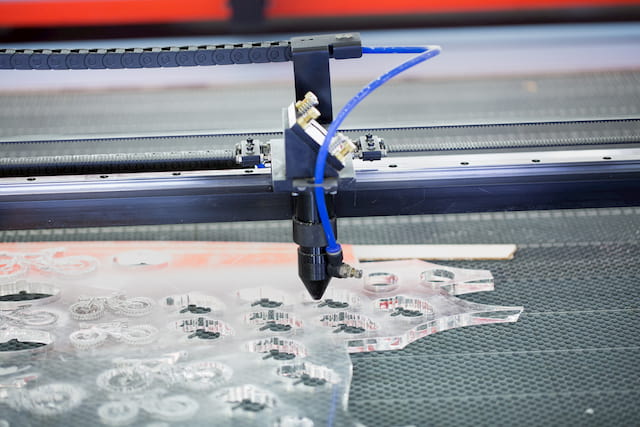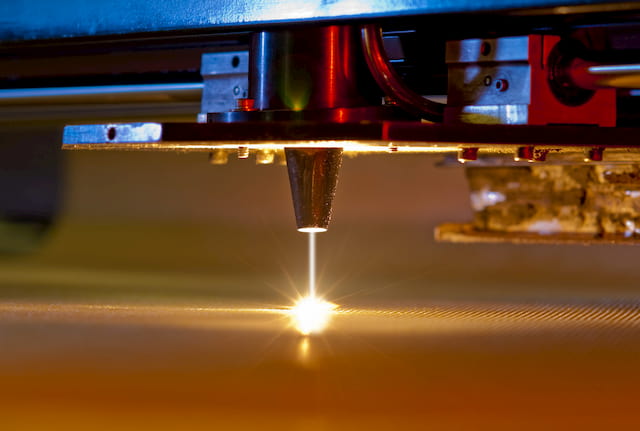Cutting is the most basic and widely used process in metal fabrication. Laser cutting is the go-to technology to perform such jobs in the industry because of its many advantages over other methods.
At the same time, it does have a few downsides as well. So let’s explore those great qualities and disadvantages more closely.
What Are the Advantages of Laser Cutting?
The reason why engineers prefer a laser cutting service lies with the long list of upsides it offers. The advantages of laser cutting are flexibility, precision, repeatability, speed, cost-effectiveness, great quality, contactless cutting, versatility and automation possibilities.
Flexibility
Laser cutting does not require an exchange of tools for each separate cut. The same setup is suitable for cutting a lot of different shapes within the same material thickness. Also, intricate cuts do not pose any problems.
Precision
Accuracy is one of the primary advantages of laser cutting when compared to other thermal cutting methods.
An accuracy of +/-0.1 mm gives an opportunity to achieve high precision without any after-treatment. In most cases, such a high standard means that no added tolerances are required.
Repeatability
+/- 0.05 mm ensures parts that are pretty much replicas of each other.
Speed
Laser cutting is a lot quicker than traditional mechanical cutting methods. Especially in the case of more complex cuts.
When comparing it to other thermal cutting methods like plasma or flame cutting, laser beats them in speed up to a certain thickness which is around 10 mm. The exact advantage point boils down to the power of the laser cutter, though.
Automation
The job needs little manpower as contemporary laser cutting machinery is highly automated. An experienced machine operator still plays a big role in the final quality but the speed of cutting and little need for manual labour result in lower costs compared to other cutting methods.
Many machines even come with feeding systems as well as follow-up conveyors. Of course, such setups make for a higher-priced laser cutting machine.
- Personal account manager
- Quality assurance
- Payment terms for companies
- On-time delivery by Fractory
Quality
Using the right setup, laser cutters only leave a small burr. Often, it is not necessary to even remove it. Of course, it depends on the material, its thickness and other factors.
Another perk is having a small heat affected zone. As the microstructure along the HAZ changes, a smaller HAZ area results in more predictable and reliable parts.
Contactless Cutting
In case of laser cutting, only the beam comes into contact with the material. Therefore, there is no mechanical friction that could wear tools.
Versatility
This is probably one of the most important aspects of laser cutting’s greatness. The versatility manifests itself in two ways.

Laser cutting is suitable for a lot of different materials. Among them are different metals, acrylic, MDF, wood, paper, etc. One machine can be configured to perform different jobs. Of course, the ability to cut some of these materials depends on the power of your machine.
Many laser cutters are not for cutting only. Laser marking is another way to utilise these machines. And marking has a lot of applications when producing everyday products.
A standard laser cutting head cannot be used for welding and a laser welding head cannot meet the cutting speeds and quality needed for cutting. Some machines allow swapping the heads if a different operation is needed to perform, combi-heads are also being developed in the background but these haven’t taken off yet due to various limitations they have.
Lastly, the technology is suitable for a variety of profiles. Tube laser cutting can perform the process on anything from box sections to open channels.
What Are the Disadvantages of Laser Cutting?
Although used to produce parts in almost every industry, laser cutting does have it downsides. Namely, the need of expertise, limitations to metal thickness, costs and hazardous fumes are all things to consider before turning to laser cutting.
Need of Expertise
As we already said, a specialist operator is a must in order to make the most of a laser cutter’s potential. The right setup makes sure the cutting quality is up to the standard people are expecting from this technology.
Limitations to Metal Thickness
Comparing laser cutting to other thermal cutting methods, it is not suitable to cut very thick plates. The largest suitable thickness depends on the available machinery and the know-how at hand. On average, metal fabrication companies tend to laser cut metal up to 15 or 20 mm.
Upfront Costs
Laser cutting machine prices can reach upwards of £1,000,000 . Lasers can be twice as costly compared to waterjet or plasma cutters. Although the running costs and efficiency make up for it in long term, the initial investment is still quite large.
Dangerous Fumes
One of the advantages of laser cutting is its suitability for cutting different materials. At the same time, the thermal cutting method makes material melt, resulting in emitted gases and dangerous fumes.
This rings especially true when cutting plastic. Thus a good, but often costly, ventilation system is a requirement for a safe working environment.




